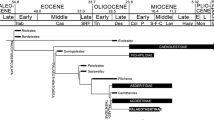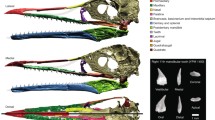Abstract
The basal non-mammaliaform cynodonts from the late Permian (Lopingian) and Early Triassic are a major source of information for the understanding of the evolutionary origin of mammals. Detailed knowledge of their anatomy is critical for understanding the phylogenetic transition toward mammalness and the paleobiological reconstruction of mammalian precursors. Using micro-computed tomography (μCT), we describe the internal morphology of the interorbital region that includes the rarely fossilized orbitosphenoid elements in four basal cynodonts. These paired bones, which are positioned relatively dorsally in the skull, contribute to the wall of the anterior part of the braincase and form the floor for the olfactory lobes. Unlike procynosuchids and the more basal therapsids in which the orbitosphenoids are well developed, dense, and bear a ventral keel, the basal epicynodonts Cynosaurus, Galesaurus, and Thrinaxodon display cancellous, reduced, and loosely articulated orbitosphenoids, a condition shared with many eucynodonts. The hemi-cylindrical orbitosphenoid from which the mammalian condition is derived re-evolved convergently in traversodontid and some probainognathian cynodonts.



Similar content being viewed by others
References
Abdala F (2003) Galesaurid cynodonts from the Early Triassic of South Africa: another example of conflicting distribution of characters in non-mammalian cynodonts. S Afr J Sci 99:95–96
Abdala F, Jasinoski SC, Fernandez V (2013) Ontogeny of the Early Triassic cynodont Thrinaxodon liorhinus (Therapsida): dental morphology and replacement. J Vertebr Paleontol 33:1408–1431
Benoit J, Abdala F, Van den Brandt MJ, Manger PR, Rubidge BS (2015) Physiological implications of the abnormal absence of the parietal foramen in a late Permian cynodont (Therapsida). Sci Nat 102(11–12):69
Benoit J, Manger PR, Rubidge BS (2016a) Palaeoneurological clues to the evolution of defining mammalian soft tissue traits. Sci Rep 6:25604. doi:10.1038/srep25604
Benoit J, Manger PR, Fernandez V, Rubidge B (2016b) Cranial bosses of Choerosaurus dejageri (Therapsida, Therocephalia): earliest evidence of cranial display structures in eutheriodonts. PLoS One 11:e0161457
Bever GS, Bell CJ, Maisano JA (2005) The ossified braincase and cephalic osteoderms of Shinisaurus Crocodilurus (Squamata, Shinisauridae). Palaeontol Electron 8.1(4A):1–36
Bonaparte JF (1962) Descripción del craneo y mandíbula de Exaeretodon frenguellii, Cabrera. Pub Mus Cienc Mar del Plata 1:135–202
Bonaparte JF, Barberena MC (2001) On two advanced carnivorous cynodonts from the Late Triassic of southern Brazil. Bull Mus Comp Zool 156:59–80
Bonaparte JF, Martinelli A, Schultz CL, Rubert R (2003) The sister group of mammals: small cynodonts from the Late Triassic of southern Brazil. Rev Bras Paleontol 5:5–27
Bonaparte JF, Martinelli A, Schultz CL, Rubert R (2005) New information on Brasilodon and Brasilitherium (Cynodontia, Probainognathia) from the Late Triassic, southern Brazil. Rev Bras Paleontol 8:25–46
Boonstra LD (1968) The braincase, basicranial axis and median septum in the Dinocephalia. Ann S Afr Mus 50:195–273
Brink AS (1955) A study on the skeleton of Diademodon. Palaeontol Afr 3:3–39
Brink AS (1959) Note on a new skeleton of Thrinaxodon liorhinus. Palaeontol Afr 6:15–22
Brink AS (1961) A new type of primitive cynodont. Palaeontol Afr 7:119–154
Brink AS (1963) A new skull of the procynosuchid cynodont Leavachia duvenhagei broom. Palaeontol Afr 8:57–75
Broom R (1938) On the structure of the skull of the cynodont, Thrinaxodon liorhinus, Seeley. Ann Transv Mus 19:263–269
Castanhinha R, Araújo R, Júnior LC, Angielczyk KD, Martins GG, Martins RMS, Chaouiya C, Beckmann F, Wilde F (2013) Bringing dicynodonts back to life: paleobiology and anatomy of a new emydopoid genus from the Upper Permian of Mozambique. PLoS One 8(12):e80974
Cluver MA (1971) The cranial morphology of the dicynodont genus Lystrosaurus. Ann S Afr Mus 56:155–274
Colbert EH, Kitching JW (1977) Triassic cynodont reptiles from Antarctica. Am Mus Novit 2611:1–30
Crompton AW (1958) The cranial morphology of a new genus and species of ictidosaurian. Proc Zool Soc London 130:183–216
Crompton AW (1964) On the skull of Oligokyphus. Bull Brit Mus Nat Hist Geol 9(4):70–82
Crompton AW, Musinsky C, Owerkowicz T (2015) The evolution of the mammalian nose. In: Dial K, Shubin NH, Brainerd EL (eds) Great transformations in vertebrate evolution. University of Chicago Press, Chicago, pp 189–203
Crompton AW, Owerkowicz T, Bhullar B, Musinsky C (2017) Origin of the Lateral Wall of the Mammalian Skull: Fossils, Monotremes and Therians Revisited. J Mammal Evol. doi:10.1007/s10914-017-9388-7
Currie PJ (1997) Braincase anatomy. In: Currie PJ, Padian K (eds) Encyclopedia of dinosaurs. Academic Press, New York, pp 81–85
Day MO, Rubidge BS, Abdala F (2016) A new mid-Permian burnetiamorph specimen from the Main Karoo Basin of South Africa and a phylogenetic review of Burnetiamorpha. Acta Paleontol Pol 61:701–719
De Beer GR (1937) The development of the vertebrate skull. The Clarendon Press, Oxford
De Beer GR (1985) The development of the vertebrate Skull. The University of Chicago Press, Chicago
Estes R (1961) Cranial anatomy of the cynodont reptile Thrinaxodon liorhinus. Bull Mus Comp Zool 125:165–180
Fernandez V, Abdala F, Carlson KJ, Cook DC, Rubidge BS, Yates A, Tafforeau P (2013) Synchrotron reveals Early Triassic odd couple: injured amphibian and aestivating therapsid share burrow. PLoS One 8(6):e64978
Fourie S (1974) The cranial morphology of Thrinaxodon liorhinus Seeley. Ann S Afr Mus 65:337–400
Fourie H (1993) A detailed description of the internal structure of the skull of Emydops (Therapsida: Dicynodontia). Palaeontol Afr 30:103–111
Gow CE (1986) The side wall of the braincase in cynodont therapsids, and a note on the homology of the mammalian promontorium. S Afr J Zool 21:136–148
Haughton (1918) Some new carnivorous Therapsida, with notes upon the brain-case in certain species. Ann S Afr Mus 12:175–216
Hopson JA (1964) The braincase of the advanced mammal-like reptile Bienotherium. Postilla 87:1–30
Hopson JA (1979) Paleoneurology. In: Glans C, Northcutt RG, Ulinski P (eds) Biology of the Reptilia. Academic Press, New York, pp 39–146
Hopson JA, Kitching JW (2001) A probainognathian cynodont from South Africa and the phylogeny of non-mammalian cynodonts. Bull Mus Comp Zool 156:5–35
Ivakhnenko MF (2013) Cranial morphology of Dvinia prima Amalitzky (Cynodontia, Theromorpha). Paleontol J 47:210–222
Jasinoski SC, Abdala F, Fernandez V (2015) Ontogeny of the Early Triassic cynodont Thrinaxodon liorhinus (Therapsida): cranial morphology. Anat Rec 298:1440–1464
Jerison HJ (1973) Evolution of the brain and intelligence. Academic Press, New York
Jones MEH, Curtis N, O’Higgins P, Fagan M, Evans SE (2009) The head and neck muscles associated with feeding in Sphenodon (Reptilia: Lepidosauria: Rhynchocephalia). Palaeontol Electron 12.2(7A):1–56
Kemp TS (1969) On the functional morphology of the gorgonopsid skull. Phil Trans R Soc B Biol Sci 256:1–83
Kemp TS (1972) Whaitsiid Therocephalia and the origin of cynodonts. Phil Trans R Soc B Biol Sci 264:1–54
Kemp TS (1979) The primitive Cynodont Procynosuchus: functional anatomy of the skull and relationships. Phil Trans R Soc B Biol Sci 285:73–122
Kemp TS (2005) The origin and evolution of mammals. Oxford University Press, Oxford
Kemp TS (2009) The endocranial cavity of a nonmammalian Eucynodont, Chiniquodon theotenicus, and its implications for the origin of the mammalian brain. J Vertebr Paleontol 29:1188–1198
Kermack KA, Mussett F, Rigney HW (1981) The skull of Morganucodon. Zool J Linnean Soc 71:1–158
Kielan-Jaworowska Z, Cifelli RL, Luo ZX (2004) Mammals from the age of dinosaurs origins, evolution, and structure. Columbia University Press, New York
Kühne WG (1956) The Liassic Therapsid Oligokyphus.Trustees of the British museum (natural history). London
Laaß M (2015) Virtual reconstruction and description of the cranial Endocast of Pristerodon mackayi (Therapsida, Anomodontia). J Morphol 276:1089–1099
Liu J, Olsen P (2010) The phylogenetic relationships of Eucynodontia (Amniota: Synapsida). J Mamm Evol 17:151–176
Luo Z (1994) Sister-group relationships of mammals and transformations of diagnostic mammalian characters. In: Fraser NC, Sues HD (eds) In the shadow of the dinosaurs: early Mesozoic Tetrapods. Cambridge University Press, Cambridge, pp 98–128
Maddison WP, Maddison DR (2009) Mesquite: a modular system for evolutionary analysis Version 2.6 http://mesquiteproject.org
Martinez RN, May CL, Forster CA (1996) A new carnivorous cynodont from the Ischigualasto formation (Late Triassic, Argentina), with comments on eucynodont phylogeny. J Vertebr Paleontol 16:271–284
Olson EC (1938) The occipital, otic, basicranial and pterygoid regions of the Gorgonopsia. J Morphol 62:141–175
Rodrigues PG, Ruf I, Schultz CL (2013) Study of a digital cranial endocast of the non-mammaliaform cynodont Brasilitherium riograndensis (Later Triassic, Brazil) and its relevance to the evolution of the mammalian brain. Paläontol Z 88:329–352
Romer AS (1970) The Chañares (Argentina) Triassic reptilian fauna VI. A chiniquodontid cynodont with an incipient squamosal-dentary jaw articulation. Breviora 344:1–18
Romer AS, Price LW (1940) Review of the Pelycosauria. GSA Spec Pap 28:1–534
Rowe T (2002-2005) Digimorph, digital morphology library, University of Texas Digital Morphology. Group. http://Digimorph.Org. Accessed: 25/11/2016
Rowe T, Carlson W, Bottorff W (1995) Thrinaxodon: digital atlas of the skull, Second edn. University of Texas Press, Austin
Rowe TB, Macrini TE, Luo ZX (2011) Fossil evidence on origin of the mammalian brain. Science 332:955–957
Rubidge BS, Sidor CA (2001) Evolutionary patterns among Permo-Triassic therapsids. Annu Rev Ecol Syst 32:449–480
Ruf I, Maier W, Rodrigues PG, Schultz CL (2014) Nasal anatomy of the nonmammaliaform cynodont Brasilitherium riograndensis (Eucynodontia, Therapsida) reveals new insight into mammalian evolution. Anat Rec 297:2018–2030
Ruta M, Botha-Brink J, Mitchell SA, Benton MJ (2014) The radiation of cynodonts and the ground plan of mammalian morphological diversity. Phil Trans R Soc B Biol Sci 280:20131865. doi:10.1098/rspb.2013.1865
Sidor CA, Smith RMH (2007) A second burnetiamorph therapsid from the Permian Teekloof formation of South Africa and its associated fauna. J Vertebr Paleont 27:420–430
Sigogneau D (1970) Revision systematique des gorgonopsiens Sud-Africains. Cahiers de Paleontologie, Paris
Sigurdsen T, Huttenlocker A, Modesto SP, Rowe TB, Damiani R (2012) Reassessment of the morphology and Paleobiology of the Therocephalian Tetracynodon darti (Therapsida), and the phylogenetic relationships of Baurioidea. J Vertebr Paleontol 32:1113–1134
Soares MB, Schultz CL, Horn BLD (2011) New information on Riograndia guaibensis Bonaparte, Ferigolo & Ribeiro 2001 (Eucynodontia, Tritheledontidae) from the Late Triassic of southern Brazil: anatomical and biostratigraphic implications. An Acad Bras Cienc 83:329–354
Sues HD (1986) The skull and dentition of two tritylodontid synapsids from the Lower Jurassic of western North America. Bull Mus Comp Zool 151:217–268
Sun AL (1984) Skull morphology of the tritylodontid genus Bienotheroides of Sichuan. Sci Sin B 27:270–284
Tatarinov LP (1974) Terriodont of USSR. Trudy Paleontologicheskii Zhurnal 143:1–226
von Huene F (1936) Die fossilen Reptilien des südamerikanischen Gondwanalandes. Ergebnisse der Sauriergrabungen in Südbrasilien 1928/29. Beck'sche Verlagsbuchhandlung, Munich
Acknowledgements
We thank K. Jakata (ESI, University of the Witwatersrand, ZA), P. Keanly (X-Sight, ZA), C. Churms (DebTech, DeBeers, ZA), G. Rougier (University of Louisville), and the European Synchrotron Radiation Facility for the provision of synchrotron radiation facilities and P. Tafforeau for the assistance in using beamline ID17. We also thank ESI preparators T. Nemavhundi and C. Dube. This research was conducted with the financial support from PAST and its Scatterlings projects, the National Research Foundation of South Africa, the Claude Leon Foundation, and the DST-NRF Centre of Excellence in Palaeosciences (CoE in Palaeosciences). Opinions expressed and conclusions arrived at, are those of the authors and are not necessarily to be attributed to the CoE in Paleosciences.
Author information
Authors and Affiliations
Corresponding author
Ethics declarations
Conflict of interest
The authors declare that they have no conflict of interest.
Additional information
Communicated by: Robert R. Reisz
Electronic supplementary material
ESM 1
(XLSX 56 kb).
Rights and permissions
About this article
Cite this article
Benoit, J., Jasinoski, S.C., Fernandez, V. et al. The mystery of a missing bone: revealing the orbitosphenoid in basal Epicynodontia (Cynodontia, Therapsida) through computed tomography. Sci Nat 104, 66 (2017). https://doi.org/10.1007/s00114-017-1487-z
Received:
Revised:
Accepted:
Published:
DOI: https://doi.org/10.1007/s00114-017-1487-z




